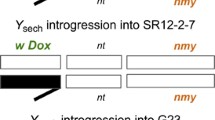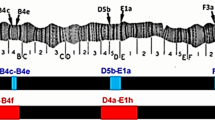Summary
Crosses between compound-2L; free-2R (free-arm) and standard strains of Drosophila melanogaster produce two classes of inviable aneuploid hybrids in equal proportions: monosomic 2L and trisomic 2L. The lethal period for monosomics occurs during embryogenesis while the trisomics survive to late pupae. Since the hybrids are inviable, standard and free-arm strains within a mixed population remain genetically isolated. Genetic isolation in the absence of mating isolation offers an extreme example of unstable equilibrium. Relative fitness data indicate that an unstable equilibrium will be established between free-arm and standard strains at a ratio of 2.5∶1. Indeed, in three cage experiments established at initial ratios of 3∶1, free arms to standards, laboratory (Oregon R) or native (Okanagan S) standard strains were completely replaced in approximately 100 days by free-arm lines derived either from laboratory or from native genetic background. In contrast, one cage established at an initial ratio of 4∶1 failed to show replacement and for 92 days remained at approximately the initial ratio. Subsequent genetic analysis of flies removed from this cage identified the presence of an anomalous strain through which genetic information was transferred reciprocally between the free-arm and standard lines. The second chromosomes carried by this strain consisted of a free-2R and a standard second on the right arm of which was attached a duplication for all of 2L. While the origin of the 2L·2R+2L chromosome was uncertain, genetic and cytological examinations revealed that it represented the reciprocal crossover product expected from an exchange that generated a F(2R). Additional crosses disclosed that the transmission frequency of the asymmetrical pair of second chromosomes, as well as their right-arm crossover products, was disproportionately in favor of the short arm. Since unequal transmission was invariably greater from female parents, this phenomenon was viewed as further evidence in support of the drag hypothesis.
Similar content being viewed by others
Literature
Bushland, R.C. (1971): Sterility principle for insect control: Historical development and recent innovations. In: Sterility Principle for insect control or eradication, pp. 3–14. Vienna: I.A.E.A.
Cantelo, W.W.; Childress, D. (1975): Laboratory and field studies with a compound chromosome strain of Drosophila melanogaster. Theor. Appl. Genet. 45, 1–6
Childress, D. (1972): Changing population structure through the use of compound chromosomes. Genetics 72, 183–186
Curtis, C.F. (1968): Possible use of translocations to fix desirable genes in insect pest populations. Nature 218, 368–369
Fitz-Earle, M. (1976): Insect population control using genetic engineering. Bull. Entomol. Soc. Amer. 22, 11–14
Fitz-Earle, M. (1978): Compound autosomes and compound; free-arm combinations for the genetic control of insect populations. Proc. North Central Branch, Entomol. Soc. Am. (in press)
Fitz-Earle, M.; Holm, D.G. (1976): The application of compound autosomes to insect control including the first experimental successes with compound-fragment combinations. Proc. XV Intern. Congr. Entomol. pp. 146–156. Washington, D.C.
Fitz-Earle, M.; Holm, D.G. (1978): Exploring the potential of compound; free-arm combinations of chromosome 2 in Drosophila melanogaster for insect control and the survival to pupae of whole-arm trisomies. Genetics 89, 499–510
Fitz-Earle, M.; Holm, D.G.; Suzuki, D.T. (1973): Genetic control of insect populations I. Cage studies of chromosome replacement by compound autosomes in Drosophila melanogaster. Genetics 74, 461–475
Fitz-Earle, M.; Holm, D.G.; Suzuki, D.T. (1975): Population control of caged native fruitflies in the field by compound autosomes and temperature-sensitive mutants. Theor. Appl. Genet. 46, 25–32
Foster, G.G.; Whitten, M.J.; Prout, T.; Gill, R. (1972): Chromosome rearrangements for the control of mosquitoes and other insect pests. Science 176, 875–880
Foster, G.G.; Whitten, M.J.; Konowalow, C. (1976): The synthesis of compound autosomes in the Australian sheep blowfly Lucilia caprina. Can. J. Genet Cytol. 18, 169–177
Grell, E.H. (1970): Distributive pairing: mechanism for segregation of compound autosomal chromosomes in oocytes of Drosophila melanogaster. Genetics 65, 65–74
Hessler, A.Y. (1958): V-type position effects at the light locus in Drosophila melanogaster. Genetics 43, 395–403
Hilliker, A.J.; Holm, D.G. (1975): Genetic analysis of the proximal region of chromosome 2 of Drosophila melanogaster. 1. Detachment products of compound autosomes. Genetics 81, 705–721
Holm, D.G. (1976): Compound Autosomes. In: Genetics and Biology of Drosophila, Vol. 1b (eds., Ashburner, M.; Novitski, E.). London: Academic Press
Li, C.C. (1955): The stability of an equilibrium and the average fitness of a population. Amer. Nat. 89, 281–296
Lindsley, D.L.; Grell, E.H. (1968): Genetic variations of Drosophila melanogaster. Carnegie Inst. Wash. Publ. No. 627
Mark, H.F.L.; Zimmering, S. (1977): Centromeric effect on the degree of nonrandom disjunction in the female Drosophila melanogaster. Genetics 86, 121–132
McKenzie, J.A. (1976): The release of a compound-chromosome stock in a vineyard cellar population of Drosophila melanogaster. Genetics 82, 685–695
McKenzie, J.A. (1977): The effect of immigration on genetic control. A laboratory study with wild and compound chromosome stock of Drosophila melanogaster. Theor. Appl. Genet. 49, 79–83
Moore, C.M. (1971): Non-homologous pairing in oogonia and ganglia of Drosophila melanogaster. Genetica 42, 445–456
Novitski, E. (1951): Non-random disjunction in Drosophila. Genetics 36, 267–280
Novitski, E. (1967): Non-random disjunction in Drosophila. Ann. Rev. Genet. 1, 71–86
Novitski, E.; Sandler, L. (1956): Further notes on the nature of non-random disjunction in Drosophila melanogaster. Genetics 41, 194–206
Robinson, A.S. (1976): Progress in the use of chromosomal translocation for the control of insect pests. Biol. Rev. 51, 1–24
Wagoner, D.E.; McDonald, I.C.; Childress, D. (1974): The present status of genetic control mechanism in the housefly Musca domestica L. In: The Use of Genetics in Insect Control (eds., Pal, R.; Whitten, M.J.), pp. 183–197. Amsterdam: Elsevier
Whitten, M.J.; Foster, G.G. (1975): Genetical methods of pest control. Ann. Rev. Entomol. 20, 461–476
Zimmering, S. (1955): A genetic study of segregation in a translocation heterozygote in Drosophila. Genetics 40, 809–825
Zimmering, S. (1976): Genetic and Cytogenetic Aspects of Altered Segregation Phenomena in Drosophila. In: Genetics and Biology of Drosophila, Vol. 1b (eds.: Ashburner, M.; Novitski, E.). London: Academic Press
Author information
Authors and Affiliations
Additional information
Communicated by A. Robertson
Supported by research grant A5853 from the National Science and Engineering Research council of Canada to D.G.H.
Rights and permissions
About this article
Cite this article
Holm, D.G., Fitz-Earle, M. & Sharp, C.B. Chromosome replacement in mixed populations of compound-2L; free-2R and standard strains of Drosophila melanogaster . Theoret. Appl. Genetics 57, 247–255 (1980). https://doi.org/10.1007/BF00264950
Received:
Accepted:
Issue Date:
DOI: https://doi.org/10.1007/BF00264950




